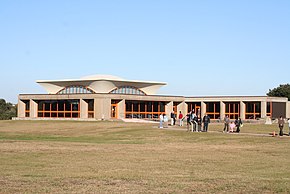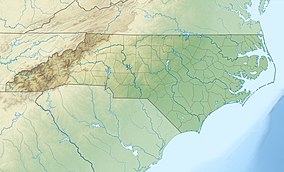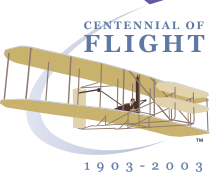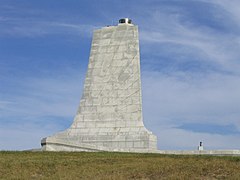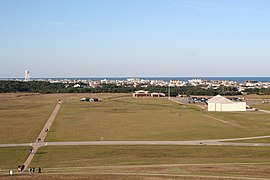
The Wright brothers, Orville Wright and Wilbur Wright, were American aviation pioneers generally credited with inventing, building, and flying the world's first successful airplane. They made the first controlled, sustained flight of an engine-powered, heavier-than-air aircraft with the Wright Flyer on December 17, 1903, four miles (6 km) south of Kitty Hawk, North Carolina, at what is now known as Kill Devil Hills. In 1904 the Wright brothers developed the Wright Flyer II, which made longer-duration flights including the first circle, followed in 1905 by the first truly practical fixed-wing aircraft, the Wright Flyer III.
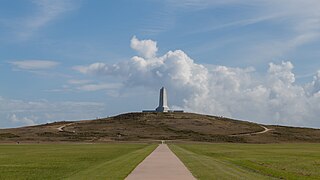
Kitty Hawk is a town in Dare County, North Carolina, on Bodie Island, part of what is known as the state's Outer Banks. The population was 3,708 at the 2020 census. It was established in the early 18th century as Chickahawk.

Kill Devil Hills is a town in Dare County, North Carolina, United States. The population was 7,633 at the 2020 census, up from 6,683 in 2010. It is the most populous settlement in both Dare County and on the Outer Banks of North Carolina. The Kill Devil Hills Micropolitan Statistical Area is part of the larger Virginia Beach-Norfolk, VA-NC Combined Statistical Area.
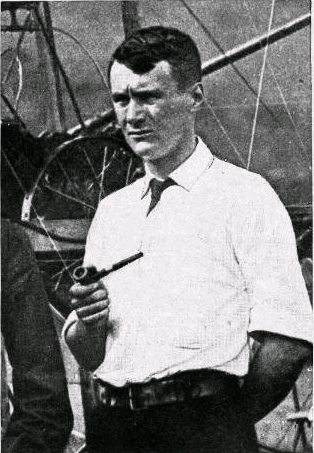
Thomas Etholen Selfridge was a first lieutenant in the U.S. Army and the first person to die in an airplane crash. He was also the first active-duty member of the U.S. military to die in a crash while on duty. He was killed while seated as a passenger in a Wright Flyer, on a demonstration flight piloted by Orville Wright.
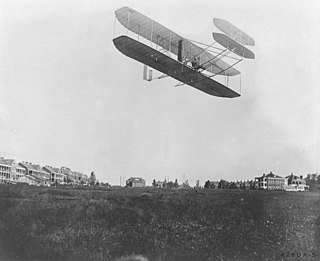
Fort Myer is the previous name used for a U.S. Army post next to Arlington National Cemetery in Arlington County, Virginia, and across the Potomac River from Washington, D.C. Founded during the American Civil War as Fort Cass and Fort Whipple, the post merged in 2005 with the neighboring Marine Corps installation, Henderson Hall, and is today named Joint Base Myer–Henderson Hall.
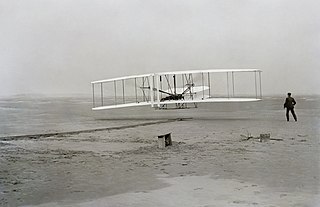
The Wright Flyer made the first sustained flight by a manned heavier-than-air powered and controlled aircraft—an airplane—on December 17, 1903. Invented and flown by brothers Orville and Wilbur Wright, it marked the beginning of the pioneer era of aviation.
The Wright Flyer III was the third powered aircraft by the Wright Brothers, built during the winter of 1904–05. Orville Wright made the first flight with it on June 23, 1905. The Wright Flyer III had an airframe of spruce construction with a wing camber of 1-in-20 as used in 1903, rather than the less effective 1-in-25 used in 1904. The new machine was equipped with the engine and other hardware from the scrapped Flyer II and, after major modifications, achieved much greater performance than Flyers I and II.
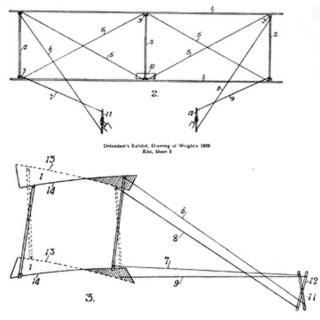
Wing warping was an early system for lateral (roll) control of a fixed-wing aircraft. The technique, used and patented by the Wright brothers, consisted of a system of pulleys and cables to twist the trailing edges of the wings in opposite directions. In many respects, this approach is similar to that used to trim the performance of a paper airplane by curling the paper at the back of its wings.

Huffman Prairie, also known as Huffman Prairie Flying Field or Huffman Field is part of Ohio's Dayton Aviation Heritage National Historical Park. The 84-acre (34-hectare) patch of rough pasture, near Fairborn, northeast of Dayton, is the place where the Wright brothers undertook the task of creating a dependable, fully controllable airplane and training themselves to be pilots. Many early aircraft records were set by the Wrights at the Huffman Prairie.

The Wright Flyer II was the second powered aircraft built by Wilbur and Orville Wright. During 1904 they used it to make a total of 105 flights, ultimately achieving flights lasting five minutes and also making full circles, which was accomplished by Wilbur for the first time on September 20.
Wright Brothers Day is a United States national observation. It is codified in the US Code, and commemorates the first successful flights in a heavier-than-air, mechanically propelled airplane, the Wright Flyer, that were made by Orville and Wilbur Wright on December 17, 1903, near Kitty Hawk, North Carolina. On September 21, 1959, U.S. President Dwight D. Eisenhower declared December 17 to be Wright Brothers Day pursuant to Public Law 86–304. Following a similar joint resolution enacted in 1961, the U.S. Congress made the designation permanent in 1963.

The Wright Model A was an early aircraft produced by the Wright Brothers in the United States beginning in 1906. It was a development of their Flyer III airplane of 1905. The Wrights built about seven Model As in their bicycle shop during the period 1906–1907, in which they did no flying. One of these was shipped to Le Havre in 1907 in order to demonstrate it to the French. The Model A had a 35-horsepower (26 kW) engine and seating for two with a new control arrangement. Otherwise, it was identical to the 1905 airplane. The Model A was the first aircraft that they offered for sale, and the first aircraft design to enter serial production anywhere in the world. Apart from the seven machines the Wrights built themselves in 1906–1907, they sold licences for production in Europe with the largest number of Model A's actually being produced in Germany by Flugmaschine Wright GmbH, which built about 60 examples.

Dayton Aviation Heritage National Historical Park is a United States National Historical Park in Dayton, Ohio that commemorates three important historical figures—Wilbur Wright, Orville Wright, and poet Paul Laurence Dunbar—and their work in the Miami Valley.

The Wright brothers designed, built and flew a series of three manned gliders in 1900–1902 as they worked towards achieving powered flight. They also made preliminary tests with a kite in 1899. In 1911 Orville conducted tests with a much more sophisticated glider. Neither the kite nor any of the gliders were preserved, but replicas of all have been built.

First Flight Airport is a public use airport located one nautical mile west of the central business district of Kill Devil Hills, a town in Dare County, North Carolina, United States. The airport is owned by the U.S. National Park Service. It is included in the National Plan of Integrated Airport Systems for 2011–2015, which categorized it as a general aviation facility.

Katharine Wright Haskell was an American teacher, suffragist, and the younger sister of aviation pioneers Wilbur and Orville Wright. She worked closely with her brothers, managing their bicycle shop in Dayton, Ohio, when they were away; acting as their right-hand woman and general factotum in Europe; assisting with their voluminous correspondence and business affairs; and providing a sounding board for their far-ranging ideas. She pursued a professional career as a high school teacher in Dayton, at a time when few middle-class American women worked outside the home, and went on to become an international celebrity in her own right. A significant figure in the early-twentieth-century women's movement, she worked actively on behalf of woman suffrage in Ohio and served as the third female trustee of Oberlin College.
Stephen H. Smith is an American sculptor best known for his interactive life-sized sculpture depicting the first flight of the Wright brothers 1903 Wright Flyer on display at the Wright Brothers Memorial in Kill Devil Hills, North Carolina. The sculpture was commissioned for the Centennial of Flight celebration by the State of North Carolina.

John Thomas Daniels Jr. was a member of the U.S. Life-Saving Station in Kill Devil Hills, North Carolina, who took the photograph of the first powered flight on December 17, 1903. The flight was by the Wright brothers flying their Wright Flyer. Daniels, who had never seen a camera before, later said that he was so excited by seeing the Flyer rising that he was unsure if he had squeezed the bulb triggering the shutter. The camera that he operated was a Gundlach Korona V view camera, which used 5-by-7-inch glass-plate negatives. The camera was owned by the Wright brothers, who were careful to record the history-making moment, and also to preserve a record for any future patent claims. The plate was not developed until the Wright Brothers returned to Ohio.

The U. S. Centennial of Flight Commission was created in 1999, by the U.S. Congress, to serve as a national and international source of information about activities commemorating the centennial of the Wright brothers' first powered flight on December 17, 1903.
The First in Flight Centennial commemorative coins are a series of commemorative coins issued by the United States Mint in 2003. The coins, issued in half dollar, dollar, and eagle ($10) denominations, commemorate the 100th anniversary of the first controlled flight of a powered heavier-than-air aircraft. The coins were authorized by Public Law 105-124.

